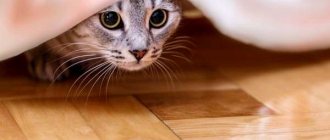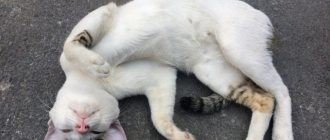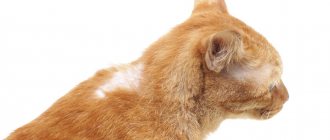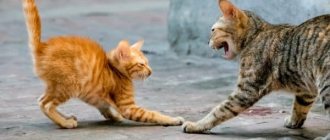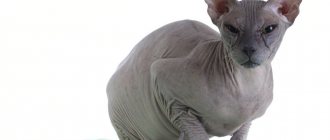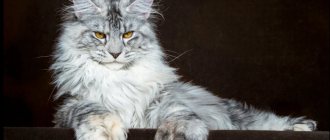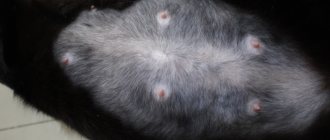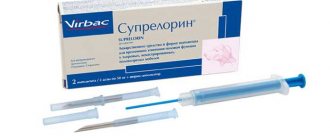The strange behavior of a cat after a haircut has a number of reasons and explanations. No matter how high-quality the procedure is, the animal experiences stress and discomfort during and after it. You should not take your pet to a groomer solely for aesthetic purposes. The main motivation should be to help the cat survive the heat or get rid of a blob of fur. If you do not consistently take care of your pet’s appearance, a number of dermatological problems will overtake it. To better tolerate the adaptation process, there are a number of rules and tips to help the owner.
Cat's reaction after haircut?
A cat may behave strangely after being cut. The following behavioral reactions are typical:
- refusal of food;
- attempts to avoid contact with people;
- desire to hide.
The first visit to the groomer is stressful for an animal, but not a single pet has ever died from it.
A cat's haircut is done for hygienic rather than aesthetic reasons. This helps regulate heat exchange in the hot season and relieve your pet of tangles that tighten the animal’s skin and cause discomfort. If you don't take care of your animal's fur, your pet may develop skin diseases: ulcers, wounds, pimples. After cutting, the hair does not grow back in clumps, but becomes shiny and even.
Reasons for behavior
Cats, when they lose their fur, behave inappropriately, as their owners think. But this is a normal reaction of an animal that has been clipped for the first time. The kitten cannot lie down quietly and wait for it to start being cut; for it, in any case, this is an uncomfortable state. He feels awkward and tries to hide. Over time, with regular visits to the groomer, the pet gets used to the procedure and behaves in the usual way. It is worth paying attention to the professionalism of the specialist. If the animal is frightened by the noise, the groomer himself, due to cruelty in treatment, then the cat may begin to hiss and scratch. If the cat was fluffy and suddenly lost its “fur coat,” it may feel cold and try to warm itself near the radiator, under the blanket. Often she shakes and hides.
Is it true that cats can be cut?
For cats that live in the private sector and spend a lot of time outdoors, careful care is essential. After a walk, your pet may return not only with dirty hair, but also with hair matted into lumps. In this case, scissors will come to your aid. And if your pet has long, thick hair, then to avoid such troubles it makes sense to get a beautiful haircut with the onset of the warm season. If your cat is domestic, and you have enough time, effort and patience to take care of your pet’s fur every day and keep it clean and tidy, you can avoid going to the “cat” hairdresser - groomer. Even if there is no need to cut your pet’s hair, it is advisable to use a fuminator or slicker; they comb out the dead undercoat without touching the living one.
Correct haircut
To make the fur reduction procedure on your cat more comfortable, you should immediately bathe the furry cat after cutting it. This is done so that the remaining fur does not prick and cause itching. It is advisable to praise the cat more, pet it, and pay attention to it so that it feels calmer. If the animal begins to shiver from the cold and look for a warm place, it is better to dress it or cover it with a blanket so that the body gets used to the temperature. It is necessary to remove piercing and sharp objects from the cat’s habitat so that the pet does not get hurt by them.
This is interesting: Lunar hair cutting calendar for November
Causes of Excessive Licking
Among the most common causes of uncontrolled licking in cats, veterinarians name:
- Manifestation of an allergic reaction to food.
- Parasitic infection.
- Problems with the digestive system and intestines, constipation.
- Skin damage due to dermatological infections or wounds.
- Reaction to moving, the appearance of a new animal, or any change in the usual environment.
- The presence of fleas or subcutaneous mites that cause itching.
- Inflammations on the skin.
If you notice a change in behavior in your pet, then you need to examine the cat. If there are no external causes, such as fleas or skin diseases, you should seek help from a veterinarian as soon as possible.
Psychological problems in an animal require immediate correction.
Sometimes frequent licking is a natural process:
- During the period of estrus and sexual hunting.
- During rehabilitation after sterilization or castration.
- After receiving a wound while walking on the street (a fight with other cats, for example).
In the cases listed above, there is no need to worry; after a few days the animal will stop licking itself and return to its previous behavior.
Cat behavior after haircut
Grooming a cat is more hygienic than aesthetic. Caring for your pet's fur can minimize the risk of skin diseases. During the warm season, a cat may suffer from the heat, in which case grooming is a great way to help your pet cope with overheating. But the most common reason why owners decide to cut their pet's hair is because of mats. After all, they can harm the cat’s health. When tangles form, the skin tightens and this can cause the animal to experience discomfort and even pain. Also, tangles are dangerous because in the places where they form, heat exchange is disrupted, which can cause the proliferation of bacteria and microbes. Cats are very clean animals. They lick themselves regularly and eat a lot of fur in the process of licking, which can negatively affect their digestion. This is also an argument in favor of a haircut.
The behavior of a cat after a haircut can change significantly, this is especially noticed by those owners who turn to the groomer for the first time. The animal may behave inappropriately, avoid contact with people, hide, and even refuse to eat. Often, owners tend to blame the groomer for this behavior; they believe that the animal began to behave inappropriately because it was treated cruelly during the grooming. However, it is not. Everything is much simpler: having lost its fur, the kitty experiences discomfort, and this causes changes in behavior. If you decide to cut your pet’s hair, it is advisable to follow some recommendations so that the cat feels most comfortable after this procedure:
1. First of all, after a haircut, it is advisable to give your pet a bath in order to wash away any remaining fur that may cause him discomfort (pricking, itching, etc.)
2. Praise the animal, try to stroke it more often, this will calm it down; 3. Unusual cold also causes discomfort in the animal, so if you notice that the cat is afraid or trying to hide in a warm place, you can put a blouse or vest on it until it gets used to the new temperature; 4. Try to ensure that the cat, at least at first, avoids contact with sharp and piercing objects, as he may get hurt.
Sometimes a cat's behavior does not change at all after a haircut. As a rule, this applies to castrated animals. They are calmer and lazier, their psyche is more resistant to irritants. But in any case, it is advisable to carry out this procedure as comfortably as possible for the pet, otherwise he may harbor a grudge against the owner.
To cut or not to cut your pet?
During a grooming, a cat gets stressed, which can lead to unpleasant consequences. However, the determining factor is the climate in which you live and where the pet spends most of its time - outdoors or indoors. When it's very hot outside and you want to help your four-legged friend, a haircut won't be a bad idea. Despite the obvious benefits (especially for long-haired cats), clipping has some disadvantages. A trimmed animal adapts less well to temperature changes. Cats walking outside can overheat in the sun, since their skin will not be protected by fur, and the pet can catch a cold. Therefore, you should not get carried away with this procedure. It is necessary to organize proper coat care, in this way you can avoid the formation of tangles and, as a result, the occurrence of skin diseases.
What happens to a cat during a grooming session with a specialist?
Doctors advise carrying out pet grooming procedures at home, and not in a specialized or veterinary clinic. A familiar environment calms the animal and does not cause tension. The statement is relative - the arrival of a stranger, incomprehensible manipulations frighten the furry pet, only the constant support of the owners can reduce the negative impact of stress factors.
This is interesting: Short haircuts for men
When traveling to the salon, the animal is subjected to great overexertion:
- The path from home to the clinic. Extraneous noises have a negative impact on the psyche, especially if the cat is constantly in the apartment and does not walk the streets. Upon arrival, he becomes aggressive or refuses to leave the carrier.
- Meet the master. Not all animals tolerate this procedure well. A stranger is perceived negatively; many pets try to scratch or bite him.
- Trimming claws. This is a must before trimming the coat. If the cat has never encountered it, then the manipulation will provoke aggression or fear towards the specialist.
- Putting on the collar. Allows a person to avoid animal bites. In the absence of contact and the furry pet’s violent behavior, the owner is offered to inject a drug that immobilizes the pet.
- Haircut process. The animal is nervous about removing hair from problem areas: the stomach, between the toes, and on the neck. The sound of a running machine adds nervousness and provokes non-stop attempts to escape.
- Removal of cut hair. This is done using a hairdryer or a damp towel. Salons prefer the first option, although it is a source of additional stress.
What is stress and what are its consequences?
When any irritating factors begin to affect the body, the reaction follows immediately. Negative suppression of the nervous system and a state of tension lead to disruption of the psycho-emotional background, its disorder and changes in behavior. A sharp surge of irritation leads to an acute state of stress, and a regular negative effect on the central nervous system leads to a chronic feeling of depression.
When a pet begins to feel unhappy, its body begins to express this in various ways:
- There is an increase in blood pressure.
- Immune functions decrease.
- Breathing becomes rapid.
- Resistance to disease weakens.
- Heart rate increases.
- The functioning of the gastrointestinal tract is disrupted.
In an acute condition, such symptoms are not dangerous for the animal, will not leave consequences and will go away quite easily. But the chronic course of stress can lead to serious complications, provoke physical and psychological exhaustion, and can even take away a significant part of the tailed pet’s life.
Why does the animal’s behavior change after the procedure?
Professional grooming does not cause physical harm - the professional acts carefully and as quickly as possible. Most injuries occur when trying to solve a problem on your own. If animals behave strangely after a haircut, this is the first sign of stress. Without the help of the owners, the cat develops and worsens severe depression.
Unusual conditions and unusual actions of a stranger
After a haircut in a salon, some animals begin to hide, avoid the owner’s attention, and demonstrate an aggressive attitude towards family members. The problem is associated with traveling to an unfamiliar place, noise, strangers and other pets. Some experts advise calling a hairdresser to your home - this will reduce the level of tension. The care of the specialist after the procedure will convince the cat that the source of the trouble has disappeared.
Veterinarians recommend carrying out manipulations in clinics or special salons - at home, the animal should feel safe, and not wait for the unpleasant person to return. The decision about where to receive hairdressing services depends only on the owner.
Effect of anesthesia
The influence of medications can reduce discomfort in a cat, but anesthesia itself is a serious test for its body. Sedative medications affect the functioning of the respiratory, cardiovascular and other systems. For this reason, grooming is carried out strictly according to indications, taking into account the individual characteristics of the animal’s body.
Before the procedure, the cat undergoes an examination, the owner is informed about the possible risks - sedation is contraindicated in case of heart disease. Most pets do not need medical assistance: an experienced groomer can easily cope with the manipulation without it.
This is interesting: Cascading haircuts for medium hair
Anesthesia and haircuts on the first day provoke inappropriate behavior in cats: they lose orientation in space, constantly sleep, or attract attention to themselves with mournful meows. Veterinarians advise avoiding sedation whenever possible to avoid side effects from medications.
Unusual sensations of a cat after a haircut
Changes in the amount and volume of fur can cause non-standard manifestations in animals:
- cats cannot lie down after being trimmed - short hair causes unusual sensations when in contact with any surfaces;
- freezing - a small draft provokes attempts to hide in a blanket, under a blanket or on a shelf with linen;
- refusal to communicate – the unusual appearance irritates the pet;
- hunger strike or continuous consumption of food - refers to manifestations of distress;
- hunting for your own tail.
How to reduce unpleasant consequences to a minimum?
To alleviate the stressful state, you need to try to gradually reconcile the animal with the procedures performed. The main method is psychological:
- rid the cat of contact with unpleasant objects - nail clippers, scissors, hair clippers;
- distract with treats, new toys, favorite activities;
- during and after the manipulations, constantly talk and stroke;
- Do not laugh or focus on the appearance of the trimmed cat.
If there are no results from psychological assistance, you should visit a veterinarian and get the necessary medications. The list of possible medications is presented:
- Pheromones - aerosols of synthetic origin. After spraying the substance, animals experience an emotional uplift and a feeling of security and safety.
- Antidepressants - prescribed by a veterinarian when a pet falls into a state of deep depression. Therapy is carried out with Valium, Diazepam.
In addition to medications, the doctor may recommend wearing a special collar soaked in pheromones and a complex of essential oils. It allows the animal to quickly get out of a stressful state and stop constantly licking itself.
Cats do not always react aggressively to hairdresser's manipulations. Indifference to procedures is observed in sterilized animals. Their psyche is more resistant to external stimuli, their behavior is characterized by calmness and pronounced laziness.
Experts point out that changing the appearance of furry pets cannot occur only at the whim of the owner; the procedure requires good reasons. The desire to create a fashionable “hairstyle” can cause a long-term quarrel between the animal and the owner, cause hidden anger in the pet and provoke a long cold war.
